2023 Amazon FBA Seller Fees: True Cost of Selling on Amazon

[ad_1]
In order to provide ecommerce entrepreneurs with all the information they need to succeed with their Amazon ventures—from launch to first sale, to growth and scaling—we’ve updated our content for 2022. The fees listed below reflect Amazon’s Fee Schedule for 2022.
Looking to start an ecommerce business? Check out our updated guides for How to Sell on Amazon, How to Sell on Walmart.com, and How to Sell on eBay in 2022.
When aspiring entrepreneurs first discover selling on Amazon, one of the big questions they inevitably ask is, “How much are Amazon FBA fees for sellers?”
After all, if you’re going to sell on the world’s largest e-commerce network, you want to make sure that you’re going to profit.
This article takes a look at the fees you’ll pay as an Amazon seller, breaking them out into four distinct sections:
And if you need a calculator for fees, simply grab our FREE Amazon FBA fees calculator below.
FBA fees all Amazon sellers must pay
Whether you are an FBA or FBM seller, these are the fees you have to pay in order to sell on Amazon.
Please see below for more information on all of the changes that will be made in 2023.
Referral fees
A referral fee is the “commission” paid to Amazon for each item sold on their platform. Typically, this fee is a flat percentage, often 15% or less.
However, you don’t have to pay these fees upfront. Instead, referral fees are taken out of your Amazon account after the sale is made.
Here is the current list of Amazon’s referral fees:
Categories
Amazon deducts the greater of the applicable referral fee percentage or applicable per-item minimum referral fee.
See “Referral fees” notes above.
Referral fee percentages
Applicable minimum referral fee
(applied on a per-unit basis unless otherwise noted)
Amazon Device Accessories
45%
$0.30
Amazon Explore
30% for Experiences
$2.00
Automotive and Powersports
12%
$0.30
Baby Products
- 8% for products with a total sales price of $10.00 or less, and
- 15% for products with a total sales price greater than $10.00
$0.30
Backpacks, Handbags, and Luggage
15%
$0.30
Base Equipment Power Tools
12%
$0.30
Beauty, Health and Personal Care
- 8% for products with a total sales price of $10.00 or less, and
- 15% for items with a total sales price greater than $10.00
$0.30
Business, Industrial, and Scientific Supplies
12%
$0.30
Clothing and Accessories
17%
$0.30
Collectible Coins
- 15% for the portion of the total sales price up to $250.00,
- 10% for any portion of the total sales price greater than $250.00 up to $1,000.00, and
- 6% for any portion of the total sales price greater than $1,000.00.
$0.30
Compact Appliances
- 15% for the portion of the total sales price up to $300.00, and
- 8% for any portion of the total sales price greater than $300.00
$0.30
Computers
8%
$0.30
Consumer Electronics
8%
$0.30
Electronics Accessories
- 15% for the portion of the total sales price up to $100.00, and
- 8% for any portion of the total sales price greater than $100.00
$0.30
Entertainment Collectibles
- 20% for the portion of total sales price up to $100.00,
- 10% for the portion of total sales price greater than $100.00, up to $1,000.00, and
- 6% for the portion of total sales price greater than $1,000.00
—
Everything Else
15%
$0.30
Eyewear
15%
$0.30
Fine Art
- 20% for the portion of the total sales price up to $100.00,
- 15% for the portion of the total sales price greater than $100.00 up to $1,000.00,
- 10% for the portion of the total sales price greater than $1,000.00 up to $5,000.00, and
- 5% for the portion of the total sales price greater than $5,000.00
—
Footwear
15%
$0.30
Full-Size Appliances
8%
$0.30
Furniture
- 15% for the portion of the total sales price up to $200.00, and
- 10% for any portion of the total sales price greater than $200.00
$0.30
Gift Cards
20%
—
Grocery and Gourmet
- 8% for products with a total sales price of $15.00 or less, and
- 15% for products with a total sales price greater than $15.00
—
Home and Kitchen
15%
$0.30
Jewelry
- 20% for the portion of the total sales price up to $250.00, and
- 5% for any portion of the total sales price greater than $250.00
$0.30
Lawn and Garden
15%
$0.30
Lawn Mowers and Snow Throwers
- 15% for products with a total sales price of up to $500.00
- 8% for products with a total sales price greater than $500.00
$0.30
Mattresses
15%
$0.30
Media – Books, DVD, Music, Software, Video
15%
—
Musical Instruments and AV Production
15%
$0.30
Office Products
15%
$0.30
Pet Products
15%, except 22% for veterinary diets
$0.30
Sports and Outdoors
15%
$0.30
Sports Collectibles
- 15% for the portion of the total sales price up to $100.00
- 10% for any portion of the total sales price greater than $100.00 up to $1,000.00
- 6% for any portion of the total sales price greater than $1,000.00
—
Tires
10%
$0.30
Tools and Home Improvement
15%
$0.30
Toys and Games
15%
$0.30
Video Game Consoles
8%
—
Video Games and Gaming Accessories
15%
—
Watches
- 16% for the portion of the total sales price up to $1,500.00, and
- 3% for any portion of the total sales price greater than $1,500.00
$0.30
Use Jungle Scout to get an accurate estimate of Amazon’s fees while doing product research.
Individual per-item fees or subscription fees
There are two types of seller accounts on Amazon: individual and professional.
Depending on the type of seller account you have, you will have to pay either the individual per-item fee Amazon charges you each time you make a sale transaction, or you will have to pay a monthly subscription fee.
Individual seller per-item fee
Individual sellers pay a flat $0.99 for each sales transaction, in lieu of a monthly subscription fee.
Like referral fees, these fees are deducted only after a sale is made on Amazon. They are then subtracted from the amount Amazon places into your Amazon account balance.
You do not have to pay the fee upfront.
Professional seller subscription fee
Rather than paying a fee per product sold, professional sellers pay a monthly subscription fee of $39.99. But, like the fees an individual seller pays, subscription fees are taken from your Amazon account balance.
If you don’t have funds in your account, then the amount is deducted from your credit card.
Refund administration fees
If a shopper requests a refund on a product for which you have already been paid and Amazon issues the refund, Amazon charges a fee to process it. The fee is either $5.00 or 20% of the refunded charge, whichever is less.
As with the other fees mentioned, the refund administration fees are immediately paid through your Amazon account balance, or charged to your credit card if your account doesn’t have the money to cover it.
Back to Top
Fees that only FBA sellers pay
If you are an FBA seller, these are the fees you’ll pay on Amazon.
FBA fees
As an FBA seller, you do not have to pay for shipping, handling, or packaging to ship your goods. Instead, Amazon’s fulfillment employees pick, pack, and ship your products for you.
To cover these costs, you are charged Amazon seller fees, which is determined by the size and weight of your product.
Below are charts showing Amazon’s current FBA fees:
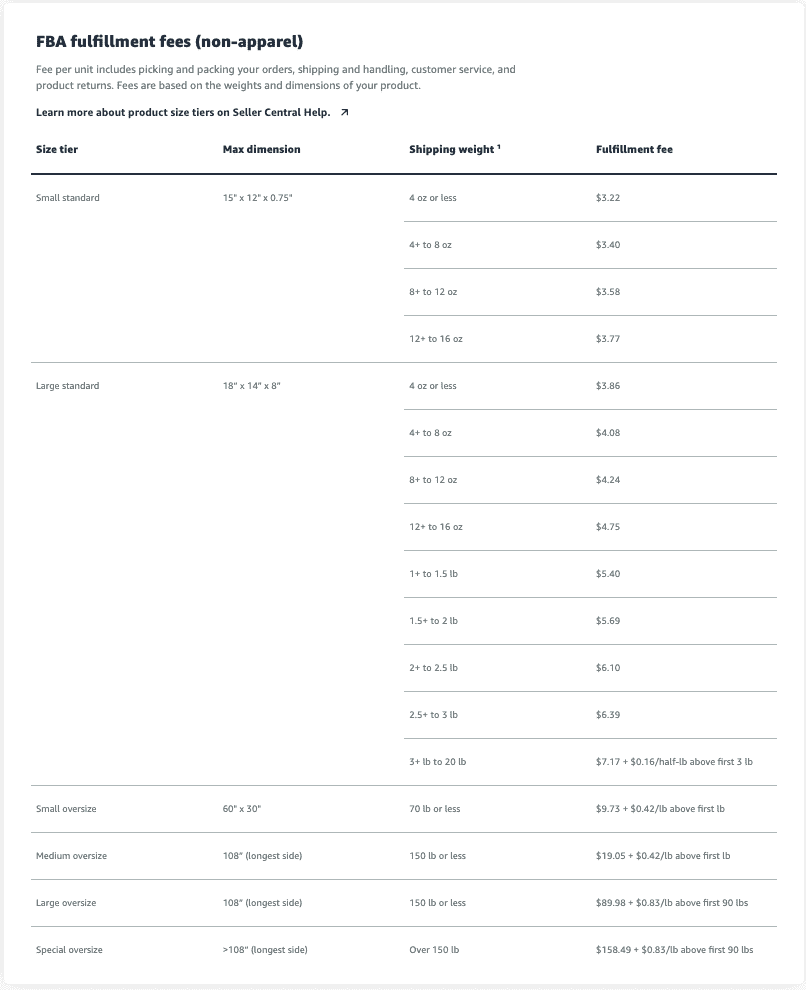
Note: Clothing, and items containing lithium batteries, have additional fees — $0.40/unit for clothing and $0.11/unit for Items containing lithium batteries.
FBA storage fees
Because your products are being stored in Amazon’s fulfillment centers, Amazon charges storage fees to maintain your inventory.
There are two types of FBA storage fees: monthly and long-term.
Monthly storage fees
If you have inventory in an Amazon warehouse at the end of the month, Amazon charges you a monthly storage fee. These are either subtracted from your account balance or added to your credit card if and when your Amazon account doesn’t have enough funds to cover the fee.
These are the current monthly storage fees for storing products in Amazon’s fulfillment centers:
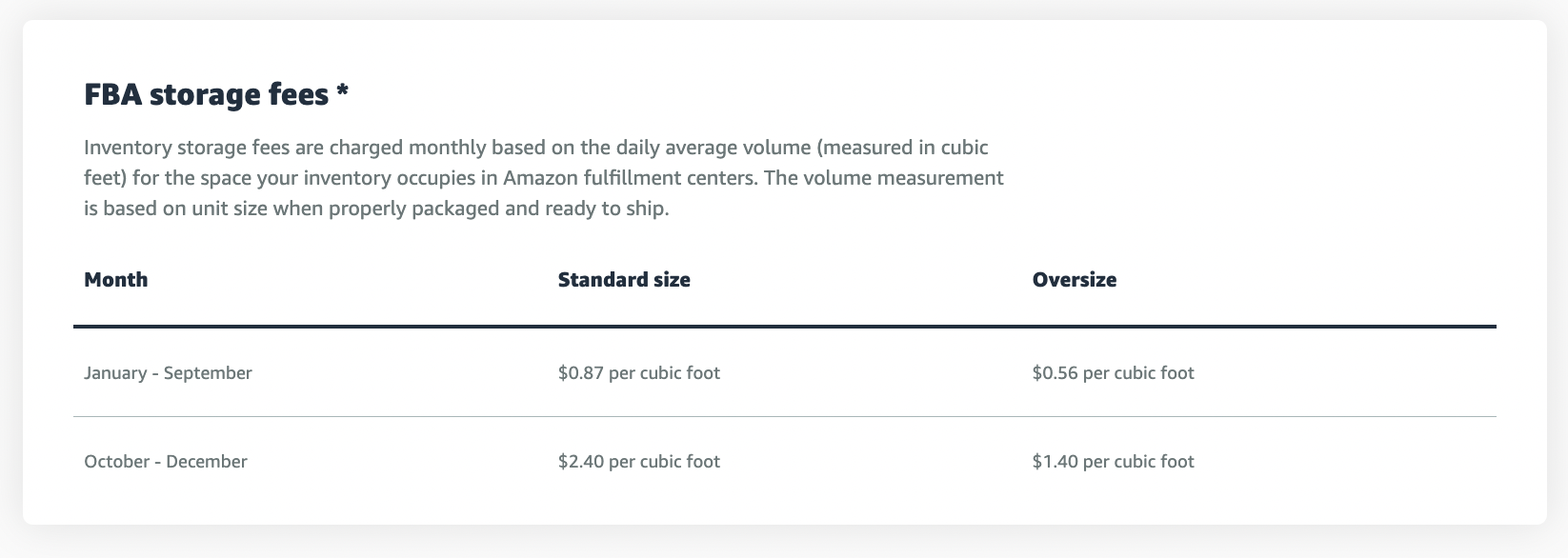
“Starting April 1, 2023, we will introduce a storage utilization surcharge for the monthly storage fee. The surcharge will be based on the storage utilization ratio, which is the ratio of your average daily inventory volume stored in cubic feet divided by the average daily shipped volume in cubic feet over the trailing 13 weeks. We will calculate the storage utilization ratio on the last day of a given month. This means that for inventory stored in April 2023, we will calculate the storage utilization ratio on April 30 and apply the surcharges in May 2023 storage fee charges.”
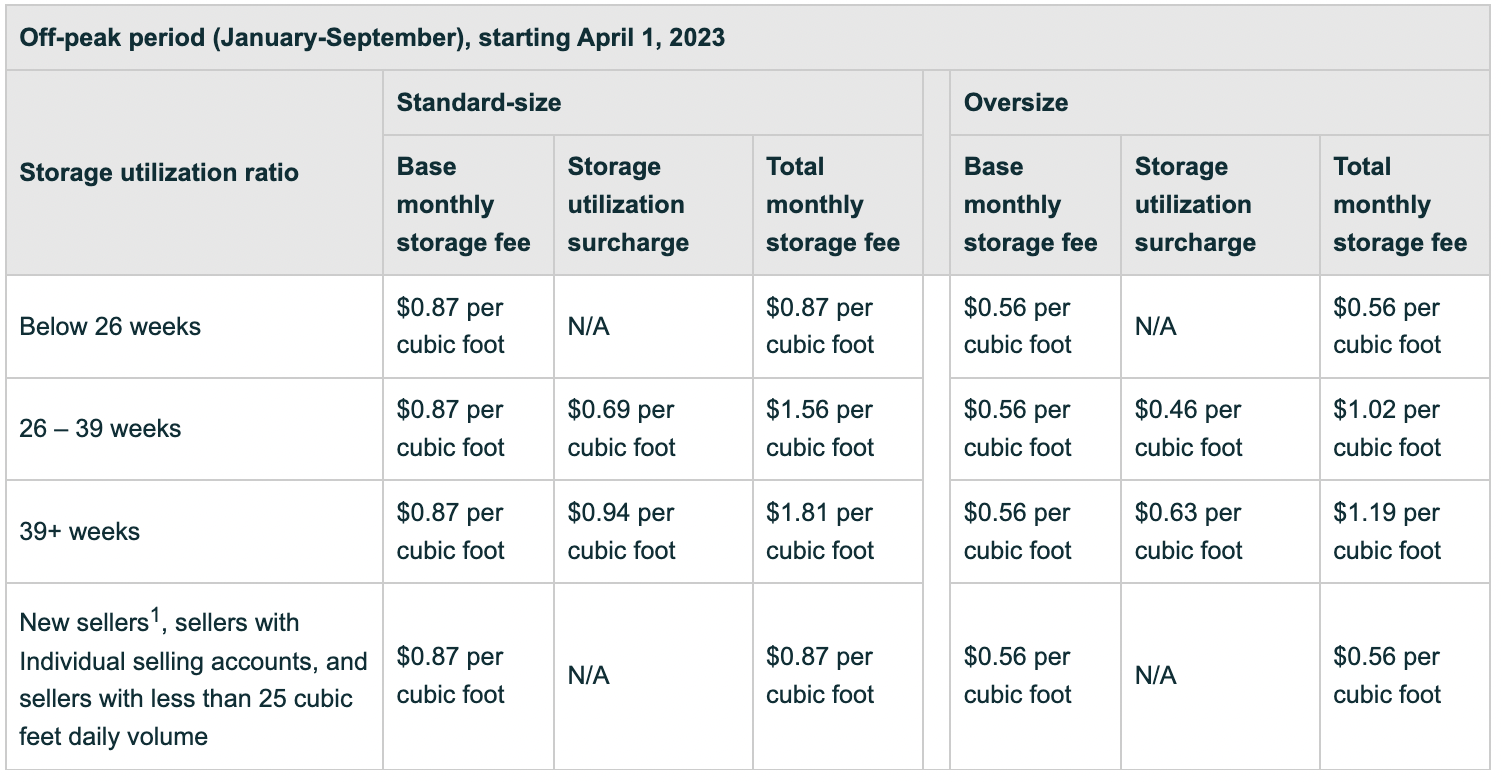
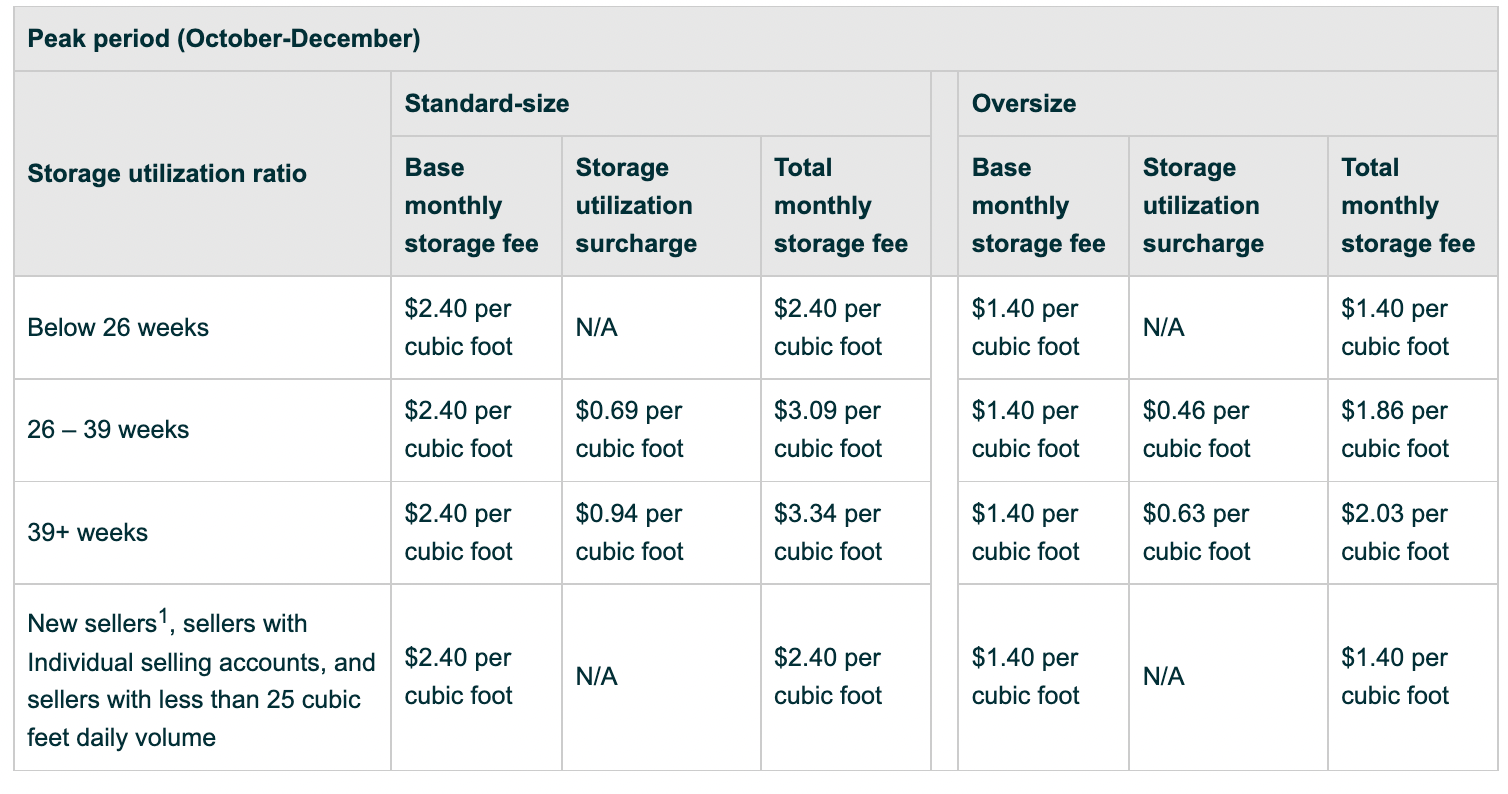
FBA aged inventory surcharge (previously known as long-term storage fees)
From Amazon:
“Starting April 15, 2023, we will increase the granularity and magnitude for the aged inventory surcharge (previously known as the long-term storage fee) on inventory stored between 271 to 365 days. Additionally, we will introduce new tiers to begin the aged inventory surcharge on inventory aged 181 to 270 days for all products except items listed under the clothing, shoes, bags, jewelry, and watches categories in the US. We will continue to charge an aged inventory surcharge for units that we store for more than 365 days.”
Amazon conducts inventory clean-ups on the 15th of each month. During the clean-up, Amazon records any products that have sat in their fulfillment centers for 181 days or longer.
For those items stored for 181 days or longer, Amazon will charge the seller an aged inventory surcharge, depending on the age of the products stored.
Like monthly storage fees, the aged inventory surcharge is deducted on the same date each month from your Amazon seller account balance or from the credit card which you put on file when you registered as an Amazon seller.
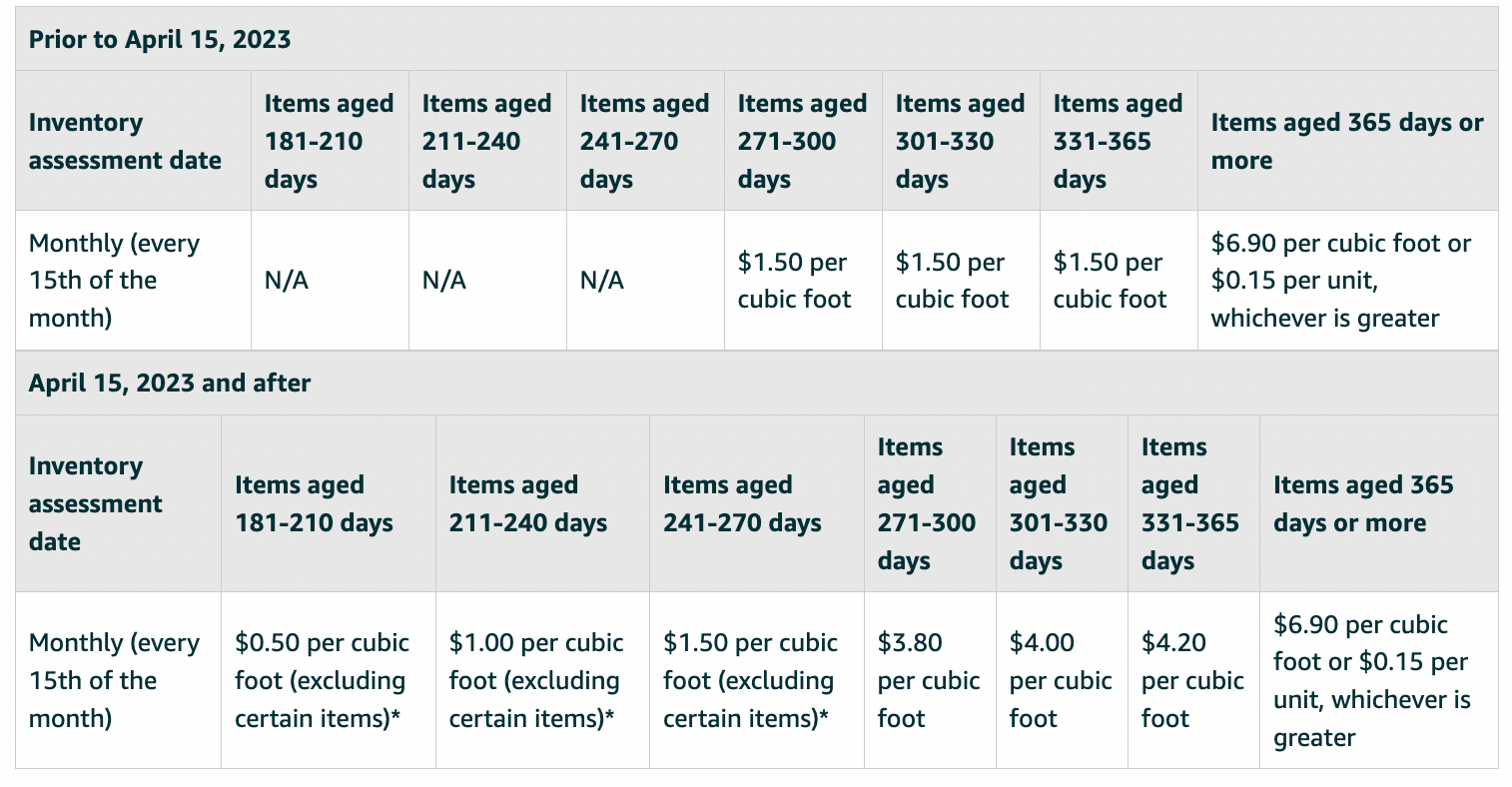
Note: During Amazon’s busy seasons, these fees will go up to persuade sellers to remove slow-selling inventory.
Back to Top
Fees that only FBM sellers pay
FBM sellers do not have their own separate fees like FBA sellers do. However, the costs to sell as an FBM seller are often higher than those of an FBA seller, since FBM sellers have to store, pick, pack, and ship their own products. They also have to handle their own customer service.
For example, if I were selling a stainless steel mug as an FBA seller for $30, I would pay $4.50 in referral fees and $5.06 in FBA fees.
If I were to sell the same product as an FBM seller, I would have to factor in the shipping costs (estimated at $6), and the cost of packaging (estimated at $1), bringing the total fulfillment cost to roughly $7 (This is before any labor or storage costs).
In this scenario, it would cost more to ship with FBM vs. FBA.
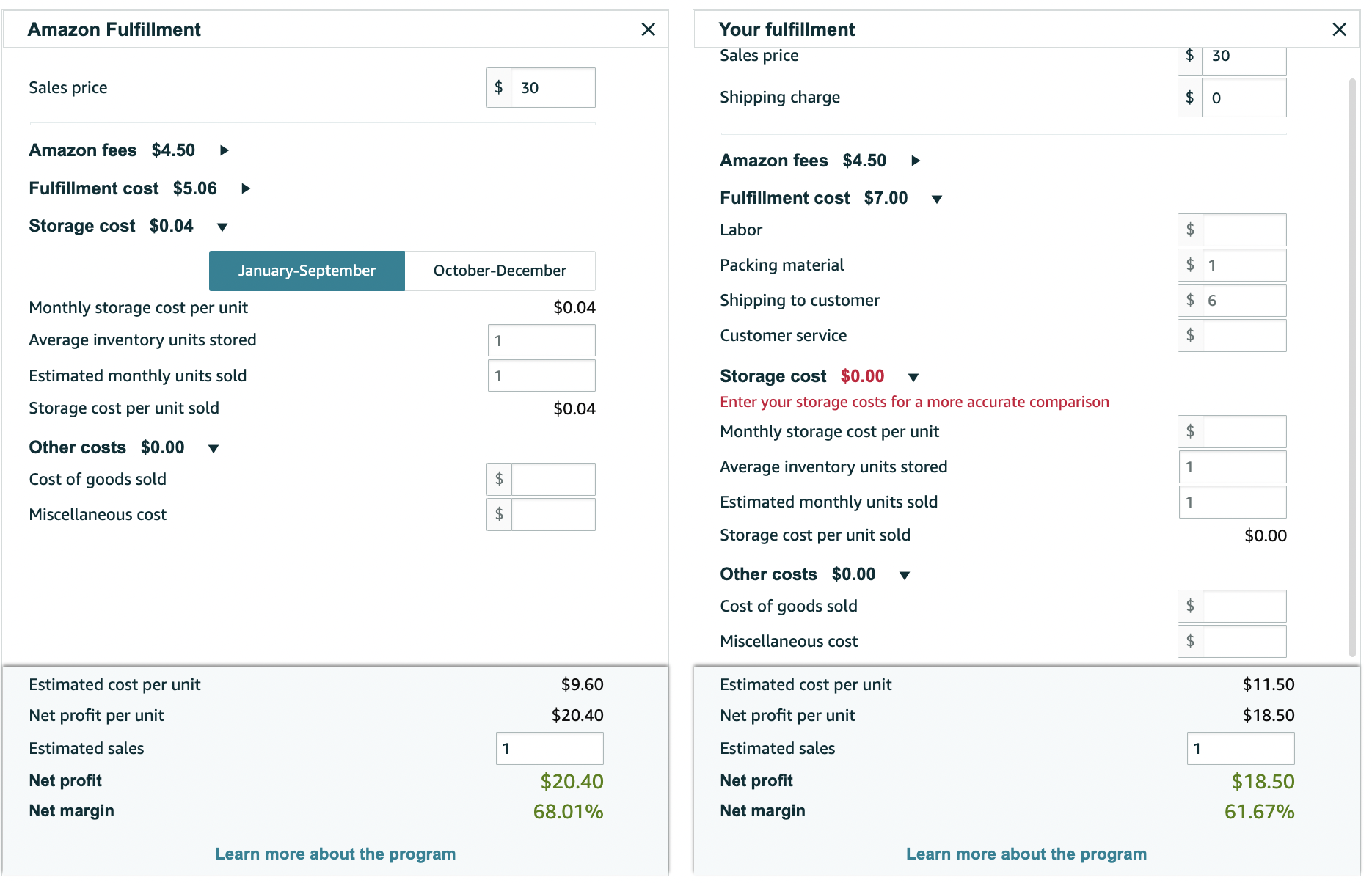
To compare FBA and FBM costs, check out Amazon’s free FBA Revenue calculator (pictured above).
Opportunity Costs: What does your labor cost you?
When choosing a fulfillment method for your business — Amazon FBM or Amazon FBA — you need to consider the cost of labor.
As an FBA seller, the cost of labor to ship your products is factored into the FBA fee. FBM sellers, on the other hand, must determine cost of labor by measuring their opportunity costs. (Opportunity costs are a way of estimating costs based on the time spent on an activity.)
The easiest way to estimate opportunity costs is to estimate what you would be paid on an hourly basis as an employee and then multiply that by the amount of time it takes you to perform the action.
For example, if you earn $40/hour at your day job and it takes you 10 minutes to fulfill a product that you sold on Amazon, the opportunity cost is $6.67.
So, while you aren’t actually paying a fee or paying someone else, it is costing you time, which costs you money.
Back to Top
Miscellaneous service fees
The last group of fees mentioned in this article are fees that only a few sellers must pay. These fees are paid regardless if you are an Amazon FBA or FBM seller.
Closing fees
Media products such as books, DVDs, CDs, and Blu-Ray, come with a flat $1.80 fee per sale, and only sellers who focus on selling these products need to worry about these fees.
Like the referral fee, the closing fees are deducted from the proceeds of the sale so you do not need to pay these fees in advance.
High-volume listing fee
Sellers with thousands of ASINs may be required to pay a monthly flat fee of $0.005 per eligible ASIN. But, unless you have more than 100,000 products listed, you won’t have to worry about these fees.
High volume listing fees are paid at the same time as FBA storage fees. These fees are deducted from your Amazon account balance. If you don’t have funds in your account balance, then the amount is deducted from your credit card.
Rental book service fees
Sellers who rent textbooks on Amazon must pay a $5.00 rental book service fee for each textbook rental that they sell.
Like referral fees, rental book service fees are deducted at the time of a sale and you will not need to pay these fees in advance.
Back to Top
Jungle Scout’s tools such as Product Database and Extension can help you estimate the fees you will need to pay for specific products. Click the link below to learn more.
How have Amazon seller fees affected your business? Were they a deciding factor in whether or not you chose to sell a specific product? Let us know in the comments below!
[ad_2]
Source link
